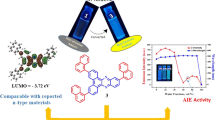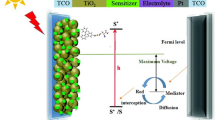Abstract
A set of CH2-, NH-, and O-substituted 2,1,3-benzothiadiazole (BTD)-based derivatives have been investigated theoretically in order to explore their electronic, optical, and charge transport properties. The calculation results show that the electronic and optical properties of the pristine molecule can be easily tuned through changing the S substituent in the central aromatic ring. Based on the calculated maximum emission wavelength, we predict that CH2-, NH-, and O-substituted BTD-based derivatives could be used as red, green, and orange light-emitting materials, respectively. After CH2-, NH- or O-substitution, the oscillator strengths of the emission spectra are enhanced with respect to that of the pristine molecule, implying that these compounds have larger fluorescence intensity. Finally, it can be deduced that CH2-, NH-, and O-substituted BTD-based derivatives may act as hole transport materials in organic light-emitting diodes.
Similar content being viewed by others
References
Li ZH, Wong MS, Fukutani H, Tao Y. Full emission color tuning in bis-dipolar diphenylamino-endcapped oligoarylfluorenes. Chem Mater, 2005, 17: 5032–5040
Yoon MH, Facchetti A, Stern CE, Marks TJ. Fluorocarbon-modified organic semiconductors: Molecular architecture, electronic, and crystal structure tuning of arene-versus fluoroarene-thiophene oligomer thin-film properties. J Am Chem Soc, 2006, 128: 5792–5801
Guo X, Qin CJ, Cheng YX, Xie ZY, Geng YH, Jing XB, Wang FS, Wang LX. White electroluminescence from a phosphonate-function-alized single-polymer system with electron-trapping effect. Adv Mater, 2009, 21: 3682–3688
Chen SF, Deng LL, Xie J, Peng L, Xie LH, Fan QL, Huang W. Recent developments in top-emitting organic light-emitting diodes. Adv Mater, 2010, 22: 5227–5239
Xiao LX, Chen ZJ, Qu B, Luo JX, Kong S, Gong QH, Kido JJ. Recent progresses on materials for electrophosphorescent organic light-emitting devices. Adv Mater, 2011, 23: 926–952
Thomas KRJ, Lin JT, Velusamy M, Tao YT, Chuen CH. Color tuning in benzo[1,2,5]thiadiazole-based small molecules by amino conjugation/deconjugation: Bright red-light-emitting diodes. Adv Funct Mater, 2004, 14: 83–90
Kato SI, Matsumoto T, Shigeiwa M, Gorohmaru H, Maeda S, Ishi-i T, Mataka S. Novel 2,1,3-benzothiadiazole-based red-fluorescent dyes with enhanced two-photon absorption cross-sections. Chem Eur J, 2006, 12: 2303–2317
Ran XQ, Feng JK, Ren AM, Li WC, Zou LY, Sun CC. Theoretical study on photophysical properties of ambipolar spirobifluorene derivatives as efficient blue-light-emitting materials. J Phys Chem A, 2009, 113: 7933–7939
Minaev B, Minaeva V, Ågren H. Theoretical study of the cyclometalated iridium(III) complexes used as chromophores for organic light-emitting diodes. J Phys Chem A, 2009, 113: 726–735
Vladimirova KG, Freidzon AY, Kotova OV, Vaschenko AA, Lepnev LS, Bagatur'yants AA, Vitukhnovskiy AG, Stepanov NF, Alfimov MV. Theoretical study of structure and electronic absorption spectra of some Schiff bases and their zinc complexes. Inorg Chem, 2009, 48: 11123–11130
Zink DM, Grab T, Baumann T, Nieger M, Barnes EC, Klopper W, Bräse S. Experimental and theoretical study of novel luminescent di-, tri-, and tetranuclear copper triazole complexes. Organometallics, 2011, 30: 3275–3283
Hu B, Zhang JP. Theoretical investigation on the white-light emission from a single-polymer system with simultaneous blue and orange emission. Polymer, 2009, 50: 6172–6185
Hu B, Zhang JP, Chen Y. Theoretical investigation on the white-light emission from a single-polymer system with simultaneous blue and orange emission (Part II). Eur Polym J, 2011, 47: 208–224
Gaussian 03, revision B. 03. Pittsburgh, PA: Gaussian Inc., 2003
Gaussian 09. Wallingford, CT: Gaussian Inc., 2009
Roothaan CCJ. New developments in molecular orbital theory. Rev Mod Phys, 1951, 23: 69–89
Pople JA, Nesbet RK. Self-consistent orbitals for radicals. J Chem Phys, 1954, 22: 571–578
McWeeny R, Diercksen G. Self-consistent perturbation theory. II. Extension to open shells. J Chem Phys, 1968, 49: 4852–4856
Parr RG, Yang W. Density Functional Theory of Atoms and Molecules. Oxford: Oxford University Press, 1989.
Ernzerhof M, Scuseria GE. Assessment of the Perdew-Burke-Ernzerhof exchange-correlation functional. J Chem Phys, 1999, 110: 5029–5036
Adamo C, Barone V. Toward reliable density functional methods without adjustable parameters: The PBE0 model. J Chem Phys, 1999, 110: 6158–6170
Perdew JP, Burke K, Ernzerhof M. Generalized gradient approximation made simple. Phys Rev Lett, 1996, 77: 3865–3868
Adamo C, Barone V. Toward reliable adiabatic connection models free from adjustable parameters. Chem Phys Lett, 1997, 274: 242–250
Foresman JB, Head-Gordon M, Pople JA, Frisch MJ. Toward a systematic molecular orbital theory for excited states. J Phys Chem, 1992, 96: 135–149
Stratmann RE, Scuseria GE, Frisch MJ. An efficient implementation of time-dependent density-functional theory for the calculation of excitation energies of large molecules. J Chem Phys, 1998, 109: 8218–8224
Bauernschmitt R, Ahlrichs R. Treatment of electronic excitations within the adiabatic approximation of time dependent density functional theory. Chem Phys Lett, 1996, 256: 454–464
Casida ME, Jamorski C, Casida KC, Salahub DR. Molecular excitation energies to high-lying bound states from time-dependent density-functional response theory: Characterization and correction of the time-dependent local density approximation ionization threshold. J Chem Phys, 1998, 108: 4439–4449
Hariharan PC, Pople JA. Accuracy of AHn equilibrium geometries by single determinant molecular-orbital theory. Mol Phys, 1974, 27: 209–214
Gordon MS. The isomers of silacyclopropane. Chem Phys Lett, 1980, 76: 163–168
Frisch MJ, Pople JA, Binkley JS. Self-consistent molecular orbital methods 25. Supplementary functions for Gaussian basis sets. J Chem Phys, 1984, 80: 3265–3269
Lee C, Yang W, Parr RG. Development of the Colle-Salvetti correlation-energy formula into a functional of the electron density. Phys Rev B, 1988, 37: 785–789
Stephens PJ, Devlin FJ, Chabalowski CF, Frisch MJ. Ab initio calculation of vibrational absorption and circular dichroism spectra using density functional force fields. J Phys Chem, 1994, 98: 11623–11627
Becke AD. Density-functional thermochemistry. III. The role of exact exchange. J Chem Phys, 1993, 98: 5648–5652
Nelsen SF, Trieber DA II, Ismagilov RF, Teki Y. Solvent effects on charge transfer bands of nitrogen-centered intervalence compounds. J Am Chem Soc, 2001, 123: 5684–5694
Nelsen SF, Blomgren F. Estimation of electron transfer parameters from AM1 calculations. J Org Chem, 2001, 66: 6551–6559
Sakanoue K, Motoda M, Sugimoto M, Sakaki S. A molecular orbital study on the hole transport property of organic amine compounds. J Phys Chem A, 1999, 103: 5551–5556
Malagoli M, Brédas JL. Density functional theory study of the geometric structure and energetics of triphenylamine-based hole-transporting molecules. Chem Phys Lett, 2000, 327: 13–17
Li XY, Tong J, He FC. Ab initio calculation for inner reorganization energy of gas-phase electron transfer in organic molecule-ion systems. Chem Phys, 2000, 260: 283–294
Lin BC, Cheng CP, Lao ZPM. Reorganization energies in the transports of holes and electrons in organic amines in organic electroluminescence studied by density functional theory. J Phys Chem A, 2003, 107: 5241–5251
Marcus RA, Sutin N. Electron transfers in chemistry and biology. Biochim Biophys Acta, 1985, 811: 265–322
Marcus RA. Chemical and electrochemical electron-transfer theory. Annu Rev Phys Chem, 1964, 15: 155–196
Bixon M, Jortner J. Electron transfer-From isolated molecules to biomolecules. Adv Chem Phys, 1999, 106: 35–202
Bolton JR, Mataga N, McLendon G. Electron transfer in inorganic, organic, and biological systems. In: Bolton JR, Mataga N, McLendon G, Eds. Advances in Chemistry Series. Washington, DC: American Chemical Society, 1991
Hutchison GR, Ratner MA, Marks TJ. Hopping transport in conductive heterocyclic oligomers: Reorganization energies and substituent effects. J Am Chem Soc, 2005, 127: 2339–2350
Author information
Authors and Affiliations
Corresponding author
Rights and permissions
About this article
Cite this article
Hu, B., Yao, C., Wang, Q. et al. CH2, NH, and O heteroatom substitution effects on the electronic, optical, and charge transport properties of a 2,1,3-benzothiadiazole-based derivative: Insights from theory. Sci. China Chem. 55, 1364–1369 (2012). https://doi.org/10.1007/s11426-012-4583-0
Received:
Accepted:
Published:
Issue Date:
DOI: https://doi.org/10.1007/s11426-012-4583-0




